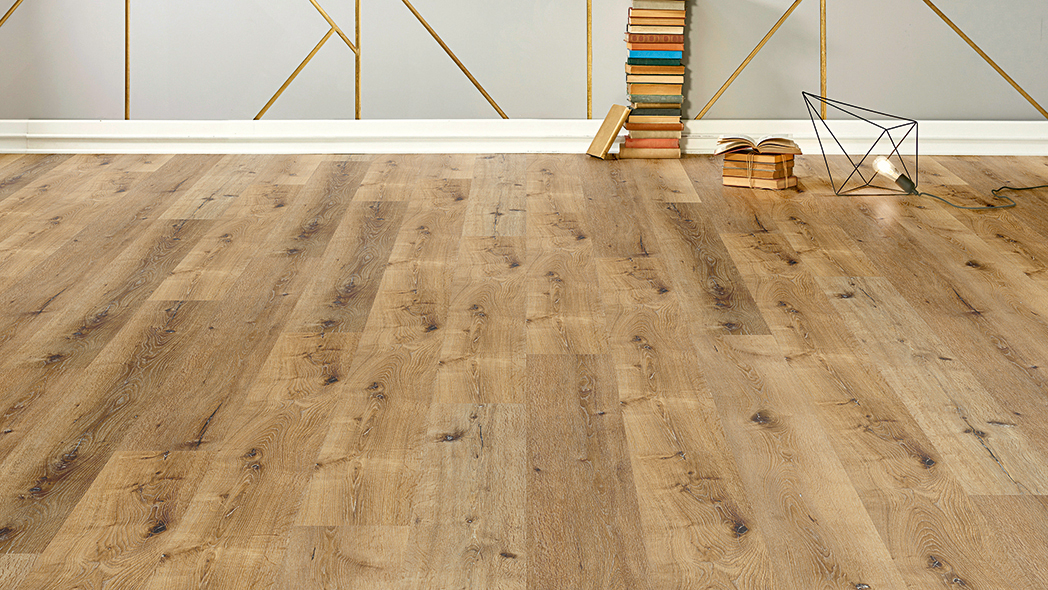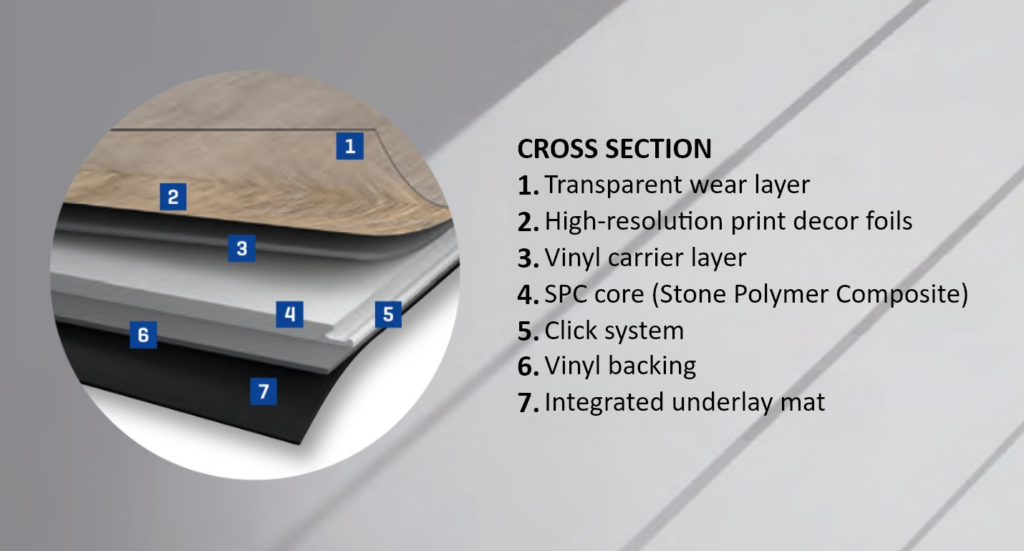
You've probably heard of rigid vinyl or SPC vinyl - the latest advancement in vinyl flooring. But what is behind this designation and what exactly makes this type of vinyl flooring so special? Is Rigid Vinyl just as easy to install as conventional solid vinyl with a click system? Get answers to these and many more questions in our article. Get to know the special product SPC Vinyl and convince yourself of its advantages.
Content
What does Rigid Vinyl / SPC Vinyl stand for?
Usually, Rigid Vinyl or SPC Vinyl means the same new type of vinyl flooring. This came onto the market only a few years ago and is convincing more and more manufacturers. Of course, you can also get the innovative Rigid Vinyl at planeo. Order free floor samples of this trendy product in our online store.
The property “rigid” refers to the rigid and dimensionally stable carrier plate, also called Rigid Board. Thus, the main difference from other vinyl flooring with click system is in the backing board.
SPC on the other hand is the abbreviation for Stone-Powder-Composite, Stone-Polymer-Composite or for Solid-Polymer-Core. In the vast majority of cases, this refers to a mixture composed of lime or stone powder and plastic. These materials give the new type of carrier plate its particularly advantageous properties. We will go into this in more detail below
What is the structure of Rigid Vinyl?
Rigid Vinyl typically consists of six layers, with the middle layer forming the carrier plate (corresponding to the 4th point "SPC core" on the cross-section graphic). This layer is responsible for the dimensional stability of the flooring. Below you can see the cross-section of an SPC vinyl with integrated impact sound insulation (underlay mat).
Please note: Point 4. (SPC core...) and point 5. (click system) refer to one and the same layer. The click system is integrated in the SPC core.

What is innovative about this type of vinyl flooring?
As mentioned before, the special feature of Rigid Vinyl lies mainly in its backing board. It is what distinguishes this type of vinyl flooring from the others. The material processed in the backing board - lime or stone powder - makes the Rigid Vinyl particularly robust. It is significantly more dimensionally stable than vinyl flooring with a pure vinyl core (also called solid vinyl or massive vinyl). At the same time, however, the click connection is also more stable, since the click system is part of the backing board (see cross-section graphic).
Although vinyl flooring is also available with an HDF (high-density fiberboard) core board, which also makes it very robust and dimensionally stable, the HDF core board has two disadvantages. First, it is made of wood fibers and is therefore more sensitive to moisture and water. Therefore, we do not recommend its use in the bathroom or other damp areas. In addition, this type of vinyl flooring has a greater installation height than the SPC vinyl.
Rigid vinyl with integrated impact sound insulation or without it.
With Rigid Vinyl, you have two variants to choose from - with integrated impact sound insulation or without. At planeo, we have found that stand-alone (separate) impact sound insulation is often more effective and better than an integrated one - provided you choose the "right" underlayment. This is particularly evident in the reduction of impact and walking noise. If you are particularly concerned about sound reduction, Rigid Vinyl without integrated impact sound insulation is right for you. You can also get a suitable self-sufficient and high-quality impact sound insulation in our online store.
If you need to do it quickly and you are willing to accept, for example, a loss in sound reduction, the variant with integrated impact sound insulation is the right thing for you. On the one hand, you do not have to look for or get a suitable carpet pad first, and on the other hand, you also save time, because you do not need to lay the carpet pad separately.
Learn more about different impact sound insulation for vinyl flooring in this guide:
Quality characteristics of SPC vinyl
Rigid vinyl is increasingly conquering the market. There are differences not only in design, but also in quality. In order to make the right decision, it is useful to know the quality characteristics. In the following, we will briefly present the two main characteristics of SPC vinyl in brief.
1. The thickness of the carrier plate
Behind the cheaper SPC vinyl is usually a thinner carrier plate. The thinner the carrier plate is, the more brittle it becomes. At the same time, the board thickness affects the stability of the click connection - if it is rather thin, the connections can break more quickly under load. A rigid board with a thickness of about 4 mm and higher is noticeably more stable than one with about 3.2 mm.
2. The number of layers
Only in cross-section can you tell how many layers a flooring consists of and how strong they are. From the top view, different rigid vinyl floors can look almost identical, but differ significantly in the structure of the layers. For example, if an SPC vinyl consists of six layers (as shown in our cross-section graphic), in most cases this is evidence of better quality than an SPC vinyl with only three layers.
Rigid Vinyl: the advantages at a glance
The new Rigid Vinyl floor is a true all-rounder. That comes as no surprise, because it is dimensionally stable, resistant and insensitive to moisture. Its insensitivity to moisture ensures its suitability for many applications. We now summarize the advantages of Rigid Vinyl clearly for you:
- More insensitive to solar radiation and temperature fluctuations.
- No acclimatization necessary, can be installed immediately without waiting time (does not apply to all manufacturers).
- More robust and dimensionally stable than classic resilient floor coverings, can be laid over areas of up to 400 sq m in one piece.n.
- Can be laid across rooms without expansion profile for smaller areas.
- No telegraph effect, minor unevenness of the subfloor or tile joints, for example, do not show in the Rigid Vinyl.
- Tolerates minor unevenness if the subfloor has not become 100% perfect.
- Pressure resistant, the risk of pressure marks is greatly reduced.
- Impact resistant, falling objects do not leave marks.
- Lower installation height compared to HDF-based click vinyl.
- Insensitive to moisture, therefore suitable for damp rooms, such as the bathroom.
- Can be used for almost all living areas, whether in the living room, bathroom or kitchen.
- Combines the best properties of the floor types vinyl and laminate.
Are there any special features when installing rigid vinyl?
You essentially install rigid vinyl like ordinary click vinyl, that is simply floating: cut with a cutter knife and then break it with a little pressure. Compared to vinyl flooring with an HDF core board, you install this flooring faster. This is due to the fact that you do not simply cut and break the HDF vinyl flooring, but have to saw with a saw.
Conclusion: Rigid vinyl (SPC vinyl) brings additional benefits.
Although the trendy click vinyl is already abundant with benefits, rigid vinyl shows off with additional advantages. The backing board has become much sturdier, but does not make installation more difficult. It is similarly stable as an HDF-based vinyl floor and at the same time insensitive to water. On the one hand, this gives you the option of installing a uniform floor covering throughout the entire house - e.g. in the living room, entrance area and in damp rooms such as the kitchen and bathroom - and on the other hand, it eliminates the telegraph effect. We at planeo see Rigid Vinyl as a successful further development of vinyl flooring.
Help with questions about Rigid Vinyl flooring
Do you still have open questions? Then simply write to us in the comments. We will answer you always, gladly and quickly! Of course, you can also reach us by phone at +49 52 22 / 960 48-0.
Your planeo Team